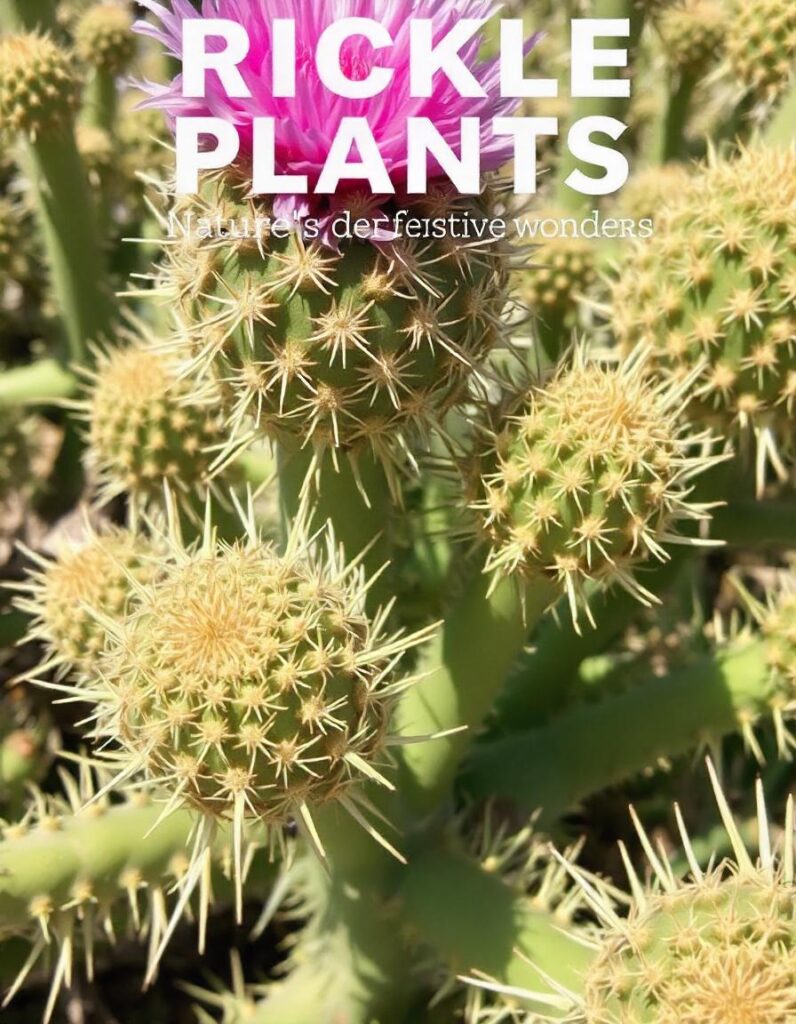Nature’s Defensive Wonders
Prickly plants are fascinating members of the plant kingdom, showcasing unique adaptations that have evolved to protect them from herbivores, environmental stressors, and other threats. These plants, which often bear sharp spines, thorns, or prickles, are more than just defensive structures; they play a crucial role in the ecosystems where they thrive. In this article, we’ll explore the different types of prickly plants, their significance in nature, and why these defensive mechanisms are essential for their survival.
Table of Contents
What Are Prickly Plants?
Prickly plants are a broad category that includes species with specialized structures such as spines, thorns, and prickles. These structures, though similar in function, arise from different parts of the plant and serve as deterrents against animals that may try to eat or damage them.
- Spines: Spines are modified leaves or parts of leaves that have evolved to be sharp and rigid. They are typically found in plants like cacti. The spines reduce water loss and protect the plant from herbivores.
- Thorns: Thorns are modified branches or stems. Unlike spines, they are deeply embedded in the plant’s tissue, making them more robust. Examples include the hawthorn tree and the crown of thorns plant.
- Prickles: Prickles are outgrowths of the plant’s epidermis or outer layer. They are generally easier to break off than spines or thorns. A classic example is the rose bush, which has prickles on its stems.
Each of these structures is designed to discourage animals from eating the plant, providing a defense mechanism that is critical for survival in various environments.

Types of Prickly Plants
Prickly plants are found in many different ecosystems, from deserts to forests, and serve a variety of functions beyond just defense. Here are a few notable examples:
- Cacti (Cactaceae Family)
- Cacti are perhaps the most well-known prickly plants. Native to the Americas, these succulents have adapted to survive in arid environments. Their spines not only deter animals but also provide shade and reduce water loss by breaking up airflow around the plant.
- Example: Saguaro cactus (Carnegiea gigantea) is famous for its towering structure and long spines.
- Agave (Agavaceae Family)
- Agaves are known for their rosettes of thick, fleshy leaves, often edged with spines or bearing sharp tips. These plants store water in their leaves, making them well-suited for dry climates.
- Example: Agave americana, commonly known as the century plant, has strong, sword-like leaves with sharp edges and tips.
- Roses (Rosaceae Family)
- While roses are celebrated for their beautiful flowers, the stems of many species are covered in prickles. These structures provide a degree of protection against animals that might otherwise try to eat the leaves or flowers.
- Example: Rosa rugosa has dense prickles on its stems and produces fragrant flowers.
- Hawthorn (Crataegus)
- Hawthorn trees and shrubs are known for their sharp thorns, which protect their berries from being eaten by animals. These plants are often used in hedgerows and natural fences.
- Example: Crataegus monogyna, commonly known as the common hawthorn, is widely used in Europe for this purpose.
- Bougainvillea
- This vibrant flowering plant is often grown as an ornamental in tropical and subtropical regions. Its stems are armed with sharp thorns that make it difficult for animals to climb or feed on it.
- Example: Bougainvillea glabra has showy bracts in a range of colors and thorny stems.
The Importance of Prickly Plants in Ecosystems
Prickly plants play an essential role in their ecosystems by providing shelter, food, and protection for various animals. Their defensive structures also contribute to maintaining balance in the ecosystem.
- Habitat and Shelter: Many animals, including birds and insects, use prickly plants for shelter. The dense network of thorns, spines, or prickles can offer a safe haven from predators. For example, birds often build nests in thorny bushes to protect their young.
- Food Source: Despite their defenses, prickly plants can be an essential food source for certain animals. For instance, desert animals such as tortoises and some species of birds are adapted to eat cacti.
- Biodiversity: Prickly plants contribute to biodiversity by supporting a range of species that rely on them for food or shelter. This, in turn, helps maintain the health and stability of ecosystems.
How Prickly Plants Benefit Humans
Prickly plants aren’t just beneficial to the environment; they also offer various advantages to humans:
- Ornamental Use: Many prickly plants, such as roses, bougainvillea, and cacti, are popular in landscaping and gardening. Their unique forms and vibrant flowers add aesthetic value to gardens and homes.
- Natural Fencing: Prickly plants like hawthorn, agave, and certain types of cacti are often used as natural barriers or fencing. Their dense, thorny growth makes them effective at keeping animals and even humans out of specific areas.
- Medicinal Use: Some prickly plants have medicinal properties. For example, the aloe vera plant, which has small spines along its leaves, is widely known for its healing properties, particularly in treating burns and skin conditions.
- Culinary Use: Certain prickly plants are edible or produce edible parts. The prickly pear cactus (Opuntia) produces fruit that is used in jellies, candies, and beverages in many cultures.
Challenges of Growing Prickly Plants
While prickly plants offer numerous benefits, growing them requires careful consideration, especially in areas with children or pets. The sharp structures can cause injury if not handled properly. Additionally, some prickly plants, such as invasive species, can spread rapidly and become difficult to control.
Here are a few tips for cultivating prickly plants safely and effectively:
- Proper Placement: Plant prickly species away from high-traffic areas to avoid accidental contact. Consider using them as natural barriers or in places where their defensive qualities are advantageous.
- Protective Gear: When handling prickly plants, wear gloves and long sleeves to prevent injuries from thorns, spines, or prickles.
- Maintenance: Regular pruning can help control the growth of certain prickly plants and prevent them from becoming overgrown or spreading beyond their designated areas.
Conclusion
Prickly plants are remarkable examples of nature’s ingenuity. Their spines, thorns, and prickles are more than just defensive mechanisms; they are vital adaptations that enable these plants to survive and thrive in challenging environments. From their ecological significance to their practical applications for humans, prickly plants hold an important place in the natural world. Whether you’re a gardener, nature enthusiast, or simply someone who appreciates the beauty of the plant kingdom, understanding and appreciating these unique plants can deepen your connection to the natural environment.
By incorporating prickly plants into your garden or landscape, you can enjoy their striking appearance while contributing to the biodiversity and health of your local ecosystem.
